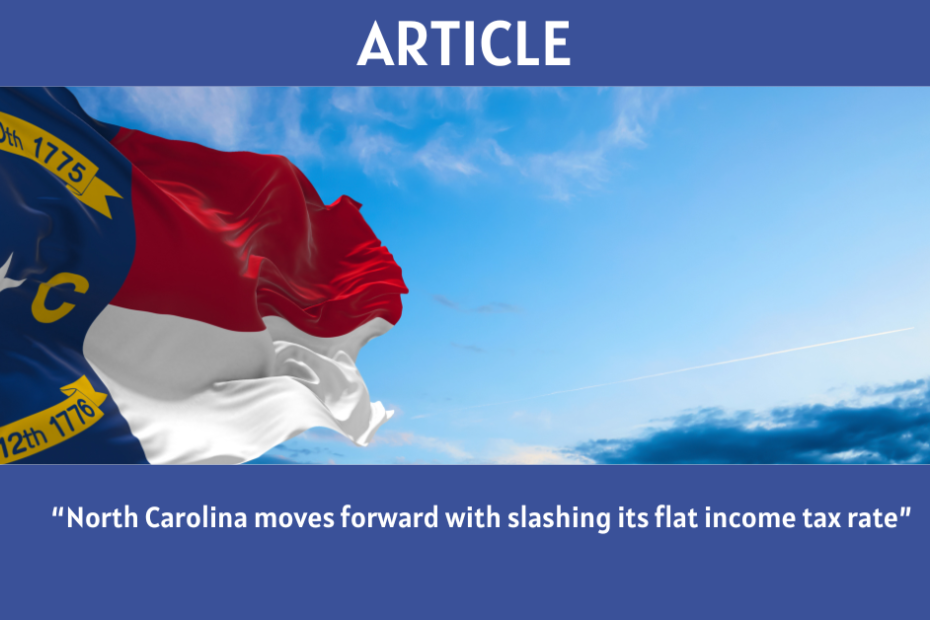Passing on the LVT option, North Carolina moves forward with slashing its flat income tax rate anyway.
On September 20th, North Carolina House and Senate leaders put forth a long-anticipated two- year budget agreement. The agreement does not include the Land Value Tax that Resource Justice outlined in a recent policy memo; however, as anticipated, it does lower the State’s income tax rate, leaving the door open for NC to surpass Arizona as the State with the lowest income taxes in the nation.
Creation of a more business-friendly environment was the driving force behind the proposed tax cut – the same goal that motivated the State’s adoption of a flat-rate income tax roughly a decade ago. Enjoying increasing popularity, particularly among red States, flat-rate income taxes are often touted as ideal for stoking the economic engine, but what exactly are they and how do they compare to the more complex, graduated income tax structures still used by the majority of States? Here we discuss what makes an income tax “flat”, review arguments made by its proponents and its critics, and take a glimpse at what the research has to say about the policy’s on-the-ground effects.
As the name suggests, a flat income tax applies the same tax rate to the earnings of all individuals (and small businesses filing through the personal, rather than the corporate income tax code), regardless of their income level. So, when NC reaches its planned income tax rate of 3.99% in 2026 (down from 4.75% in 2022) taxpayers’ obligations will be calculated using this rate whether they made $20K or $20M in a given year.
Proponents of flat taxes point to their simplicity as their greatest strength. The argument goes that because flat taxes are more straightforward and transparent than a graduated tax structure, taxpayers and government officials can determine liabilities with less effort, and with fewer opportunities for honest mistakes or intentional evasion.
Economic growth, spurred by tax reductions for wealthier individuals (and small businesses filing as individuals), is another outcome often mentioned by fans of flat income taxes. Lower and consistent tax rates, they reason, incentivize savings, investment, and economic activity among a State’s more affluent taxpayers, while discouraging out-migration in search of more favorable tax climates.
Flat taxes are also often seen as a tool to reign in potential government overreach and encourage fiscal discipline. Because proposed increases cannot be targeted at specific income brackets, they are highly visible to the entire voting public, potentially chastening politicians on the hunt for additional revenue. As Arizona Governor Norquist explained it in a 2022 article describing his State’s use of a flat income tax, “Graduated taxes divide taxpayers into groups, allowing politicians to play them against each other and ultimately rob them all, one at a time. Flat or single rate taxes, on the other hand, put all taxpayers on the same team and require politicians to answer to everyone together.”
Clearly, there are reasons to consider a flat income tax, but not everyone is a fan. So, what are the downsides of this policy?
At a basic level, many critics contend that the supposed benefits of a flat tax do not, in fact, manifest as described above. Standard tax software makes calculating obligations across income brackets easy, and a single rate does not impart transparency or diminish bad taxpayer behaviors if, as is often the case, it is accompanied by carve outs for various segments of the tax base. Further, empirical evidence to support the claim that tax savings among the wealthy translates to greater economic investment in the taxing jurisdiction, or stems out-migration, is lacking.
But the most fundamental argument made against the flat income tax is that it eliminates progressivity, failing the vertical equity test and widening the financial divide between haves and have-nots in the process. A 2023 study by the Institute on Taxation and Economic Policy, for example, found that average effective state income tax rates were higher for the lowest 80% of earners under a flat income tax than a graduated one – and that the difference was starkest for the lowest 20% of earners, totalling a full percentage point.
In seeking to create a business-friendly tax climate, North Carolina lawmakers are cutting the rate of their flat income tax – a tax structure already explicitly conceived to help bolster the State’s tax competitiveness. Proponents of flat income taxes point to their transparency, simplicity, and an expectation that they can better incentivize (I hate “incent”) economic growth than their graduated counterparts as evidence of their superiority. Skeptics cast doubt on the ability of flat income taxes to fulfill expectations, and highlight the regressive nature of these taxes in arguments against their use. Whether for or against flat income taxes at the State level, however, the decision to lower rates creates a fiscal shortfall that must be accounted for. So, while legislators have identified some mechanisms (including new taxes on vapes and ride shares and the sale of “fast passes” for lobbyists looking to bypass security at the State Capitol), adoption of a statewide LVT remains an option worth considering in the future.
- Nine States do not collect income tax. Among those that do, North Carolina would have the lowest rate, should provisions be met to reduce the rate to its lowest possible projection of 2.49%.

